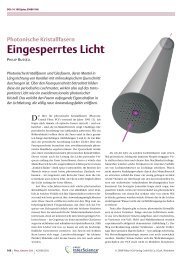Diploma thesis
Diploma thesis
Diploma thesis
Create successful ePaper yourself
Turn your PDF publications into a flip-book with our unique Google optimized e-Paper software.
dark counts, afterpulsing, stray light and remaining pump photons. To distinguish<br />
all these effects we constructed a coincidence setup where we employed the strict<br />
photon number correlation between signal and idler photons.<br />
The setup sketched in Figure 4.42 is pumped at 760 nm with a pump FWHM<br />
around 10 nm. We used a long wave cutoff filter of about 1000 nm and a short<br />
wave cutoff filter at 700 nm to get rid of unwanted light from the laser system. Our<br />
goal is to excite the type-II process in the crystal. Precise control over the pump<br />
polarization is necessary therefore we controlled it with a Glan-Thompson polarizer.<br />
The first half-wave plate in front of the polarizer served as a power control, the<br />
second half-wave plate after the polarizer turned the pump polarization in the yplane.<br />
Afterwards the beam is coupled into a polarisation maintaining fiber and fed<br />
into the crystal. After the downconversion a long wave pass filter is applied to get<br />
rid of the remaining pump light. Signal and idler beams are separated by a PBS,<br />
coupled into single mode fibers and guided into the APDs. The signals have been<br />
post processed with a time-to-digital converter (TDC), which evaluated the number<br />
of coincidence counts [27].<br />
Figure 4.42: Measurement setup to detect signal and idler photon-pairs<br />
We achieved count rates around 3200 events per second for each detector and a<br />
coincidence level of 94 coincidences per second (see table 4.5).<br />
This setup may further be improved by the use of lenses to couple into the SMfibers.<br />
At the moment we apply microscope objectives to couple into the single mode<br />
fibers. The coupling efficiency is around 60%. The challenge is to couple the guided<br />
modes emitted by the rectangular waveguide into the emission modes of a circular<br />
single mode fiber. These two different modes don not perfectly match each other,<br />
therefore the incoupling efficiency is limited and will never reach 100%.<br />
60



